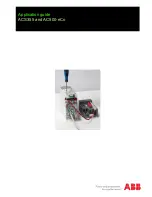
Axcera-430B FCC Type Acceptance Report Parts List/Tune-up Info
February 2004
7-14
3.
Center the aural carrier on the spectrum analyzer with the spectrum analyzer set to
the following:
Frequency/Division – 10 kHz
Resolution bandwidth – 3 kHz
Time/Division – 50 msec
Trigger – Free run
A. Adjust L5 for approxi3.5 VDC at TP2.
B. The green LED DS1 should be illuminated, indicating a locked condition. If not,
re-tune L5 for a locked condition.
4.
Adjust R13, balanced audio gain, on the aural IF synthesizer board for a ±25-kHz
deviation.
5.
Check the distortion on the aural distortion analyzer (THD=< 0.5%).
6.
Disconnect the 600-
Ω
balanced audio input to the tray. Connect a 75-
Ω
stereo
audio input (400 Hz at 1 Vpk-pk) to composite audio input jack J3 on the rear of the
tray. Follow the procedures in the stereo generator instruction manual for matching
the level of the generator to the exciter. Use R17 to adjust the composite audio
gain.
7.
Check the distortion level on the distortion analyzer (THD=< 0.5%)
7.2.12.8 ALC Board (Part 1 of 2)
Table 7-2 describes the functions of each LED on (A8) the ALC board.
Table 7-2. ALC Board LEDs
LED
FUNCTION
DS1 (Red LED)
Indicates that an abnormally low IF signal
level is present at IF input connector J1
DS2 (Red LED)
Indicates that the ALC circuit is unable to
maintain the level requested by the ALC
reference due to excessive attenuation in
the linearity or the IF phase corrector
signal path or because jumper W3 on J6 is
in manual gain
DS3 (Red LED)
Indicates a video loss fault
DS4 (Red LED)
Indicates that a Mute command is present
DS5 (Green LED)
Indicates that the output from the
modulator is selected as the input to the
board
Summary of Contents for 430B
Page 58: ......
















































